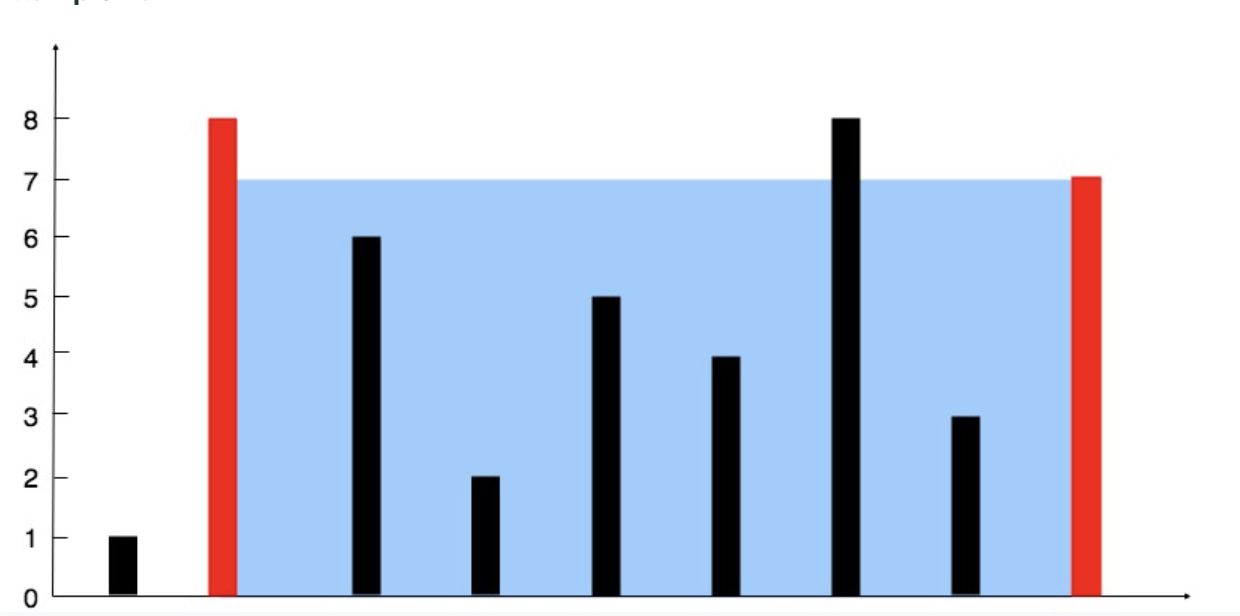LeetCode Container With Most Water
Problem statement
Given N non-negative integers a1, a2, ..., an, where each represents a point at coordinate (i, ai). N vertical lines are drawn such that the two endpoints of the line i is at (i, ai) and (i, 0). Find two lines, which, together with the x-axis forms a container, such that the container contains the most water.
Problem statement taken from: https://leetcode.com/problems/container-with-most-water
Example 1:

Input: height = [1, 8, 6, 2, 5, 4, 8, 3, 7]
Output: 49
Example 2:
Input: height = [1, 1]
Output: 1
Example 3:
Input: height = [4, 3, 2, 1, 4]
Output: 16
Example 4:
Input: height = [1, 2, 1]
Output: 2
Constraints:
- N == height.length
- 2 <= N <= 10^5
- 0 <= height[i] <= 10^4
Explanation
Brute force
A brute force approach is to consider the area of every possible pair of lines and find out the maximum among them.
A C++ snippet of the approach will look like below:
public class Solution {
public int maxArea(int[] height) {
int ans = 0;
for (int i = 0; i < height.length; i++)
for (int j = i + 1; j < height.length; j++)
ans = Math.max(ans, Math.min(height[i], height[j]) * (j - i));
return ans;
}
}The time complexity of the approach is O(N^2) since we are running two nested for loops and considering every subset of the array.
Two pointer
The time complexity can be reduced by using two-pointers. We know that the farther the lines more area will be obtained. But the area formed between the lines will be constrained by the height of the shorter line.
Algorithm
- set left and right pointer to 0 and last index of array height
- set ans = 0. Variable ans holds the max area of our solution
// Iterate array from both ends and
- Loop while left < right
- get the area between to indices
- area = min(height[left], height[right])*(right - left)
- get the maximum of ans and area and update ans
- ans = max(ans, area)
- increment left or right based on which of the index value is minimum.
- if height[left] < height[right]
- increment left++
- else
- increment right++
- return ans
C++ solution
class Solution {
public:
int maxArea(vector<int>& height) {
int left = 0;
int right = height.size() - 1;
int ans = 0;
while(left < right){
ans = max(ans, min(height[left], height[right])*(right-left));
if(height[left] < height[right]){
left += 1;
} else {
right -= 1;
}
}
return ans;
}
};Golang solution
func maxArea(height []int) int {
left, right := 0, len(height) - 1
area := 0
for left < right {
area = max(area, min(height[left], height[right])*(right - left))
if height[left] < height[right] {
left++
} else {
right--
}
}
return int(area)
}
func max(a, b int) int{
if a > b {
return a
}
return b
}
func min(a, b int) int{
if a < b {
return a
}
return b
}Javascript solution
var maxArea = function(height) {
if (height.length < 2){
return 0;
}
let left = 0;
let right = height.length - 1;
let ans = 0;
while (left < right) {
ans = Math.max(ans, Math.min(height[left], height[right]) * (right - left) );
if (height[left] < height[right]){
left += 1;
} else {
right -= 1;
}
}
return ans;
};Dry Run
Let's dry-run our algorithm to see how the solution works.
height = [1, 8, 6, 2, 5, 4, 8, 3, 7]
left = 0
right = height.size() - 1
= 9
ans = 0
Step 1: left < right
0 < 8
true
ans = max(ans, min(height[left], height[right])*(right-left));
= max(0, min(1, 7)*(8-0))
= max(0, 1*8)
= max(0, 8)
= 8
height[left] < height[right]
1 < 7
true
left++ = 1
Step 2: left < right
1 < 8
true
ans = max(ans, min(height[left], height[right])*(right-left));
= max(8, min(8, 7)*(8-1))
= max(8, 7*7)
= max(8, 49)
= 49
height[left] < height[right]
8 < 7
false
right-- = 7
Step 3: left < right
1 < 7
true
ans = max(ans, min(height[left], height[right])*(right-left));
= max(49, min(8, 3)*(7-1))
= max(49, 3*6)
= max(49, 18)
= 49
height[left] < height[right]
8 < 3
false
right-- = 6
Step 4: left < right
1 < 6
true
ans = max(ans, min(height[left], height[right])*(right-left));
= max(49, min(8, 8)*(6-1))
= max(49, 8*5)
= max(49, 40)
= 49
height[left] < height[right]
8 < 8
false
right-- = 5
Step 5: left < right
1 < 5
true
ans = max(ans, min(height[left], height[right])*(right-left));
= max(49, min(8, 4)*(5-1))
= max(49, 4*4)
= max(49, 16)
= 49
height[left] < height[right]
8 < 4
false
right-- = 4
Step 6: left < right
1 < 4
true
ans = max(ans, min(height[left], height[right])*(right-left));
= max(49, min(8, 5)*(4-1))
= max(49, 5*3)
= max(49, 15)
= 49
height[left] < height[right]
8 < 5
false
right-- = 3
Step 7: left < right
1 < 3
true
ans = max(ans, min(height[left], height[right])*(right-left));
= max(49, min(8, 2)*(3-1))
= max(49, 2*2)
= max(49, 4)
= 49
height[left] < height[right]
8 < 2
false
right-- = 2
Step 8: left < right
1 < 2
true
ans = max(ans, min(height[left], height[right])*(right-left));
= max(49, min(8, 6)*(2-1))
= max(49, 6*1)
= max(49, 6)
= 49
height[left] < height[right]
8 < 6
false
right-- = 1
Step 9: left < right
1 < 1
false
return ans as 49